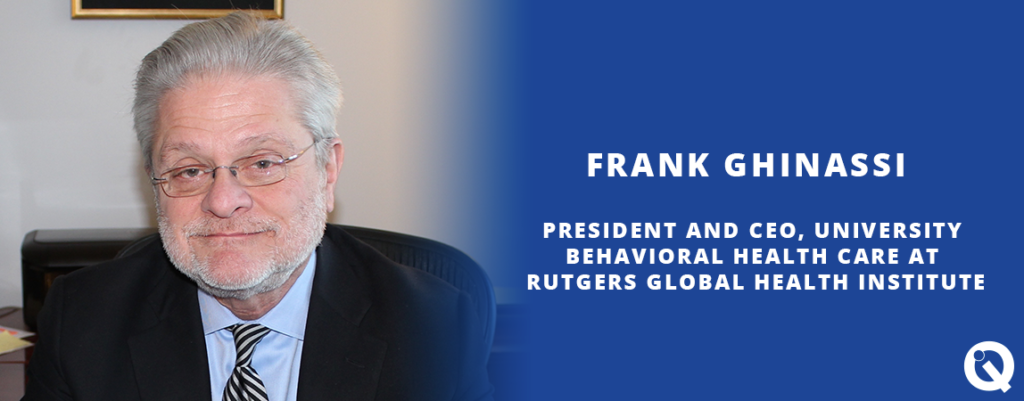Frank Ghinassi, President and CEO, University Behavioral Health Care at Rutgers Global Health Institute.
Your organization works closely with the New Jersey Medicaid program. Can you describe how that relationship works to support people with mental health issues?
The Medicaid program provides coverage for a robust, multi-level and multi-dimensional network of care for individuals eligible for the program. Here at Rutgers Health UBHC, our Medicaid eligible continuum of care includes a wide array of outpatient psychotherapy and case management clinics, acute care hospital beds, psychiatrist and advance practice nurse-delivered evaluation and medication management, social worker-and-psychologist-delivered psychosocial interventions services, including individual, group, and family therapy. Rutgers Health UBHC also provides partial hospitalization programs, intensive outpatient programs, along with school-based care. And, increasingly, we’re integrating behavioral healthcare into family, primary care and pediatric practices.
What do you see as the barriers impacting access to behavioral health services?
In 2019, the stigma associated with behavioral health and addictions disorders is far less pervasive than it was when I started my career in the early eighties. Then, most individuals and families were reluctant to admit that they had a behavioral health or addiction disorder. Even today, many people are still worried that if their family or their employer finds out that they are clinically depressed or dealing with an addiction disorder that it might damage their reputation and impair their ability to succeed at work, school, or with their family and friends. About half of the people, for example, who live with depression often do not seek professional help. So stigma continues to be a significant barrier.
In addition, for decades, the insurance coverage available for behavioral health and addiction disorders was not as robust as it was for physical health conditions. There were larger co-pays, lifetime “limits” and other structural coverage limitations. Imagine someone saying we’re only going to treat your diabetes for two years? Coverage today is better, but still an issue, especially for people who work for small employers. And for the Medicaid population, there are many environmental and social determinants of health, such as poverty, lack of childcare, lack of stable housing, and lack of transportation.
How are you using performance measurement and feedback to keep improving quality?
We measure a wide variety of process and outcome indicators of health and wellness, along with the evidence base for, and the adequacy of, the “dose” of care. For example, what percentage of people are still coming to appointments after the initial diagnosis and treatment plan? Or, of people who start a medication, say treatment for depression, how many are still taking and refilling their medication in six months? We may use a depression inventory or an anxiety inventory, to track the degree of change and /or and severity of your symptoms. We are focused on measuring your functional effectiveness, as in how well are you engaging in work, school, and social activities?
And we look at secondary things. Are people also taking care of their physical health? If you come in and we’re treating you for a psychotic disorder, are we making sure that we’re helping you keep your weight down and that we’re helping you monitor your A1C and that we’re taking care of pre-diabetic conditions? I personally sit on a number of CMS performance measurement review and approval committees and I work closely and sit on several committees within the National Quality Forum. So, we not only believe in performance measurement, but we’re actively involved at the national level in approving and making these measures better.
Your work was described as being at the interface between physical health and mental health and addiction. Could you elaborate on your work to change how people receive mental health treatment in New Jersey?
The idea of a mind/body split came out of very, very early beliefs of body and spirit, hundreds if not thousands of years ago. Mental health disorders were considered to be due to religious failing or purnishment, or supernatural forces. As things evolved, behavioral health was delivered in different settings, different buildings, via different payment structures. Physical health care delivery centers often don’t feel they have the time — or didn’t have the expertise — to talk about depression or anxiety. People, on the other hand, experience their health in both their mind and their bodies…as one. We need to integrate behavioral health screening for early identification and treatment into the places where most people are already going for their physical health — so that means their primary care providers, family medicine, pediatric or obstetric practices. We’ve been using something called the Cherokee Health System model, which is a particular model of truly integrated physical health and behavioral health care. And we’re working closely with The Nicholson Foundation to change the curriculum in Rutgers medical schools and the rest of the schools of biomedical and health sciences. Health care delivery students will learn from the start that physical and behavioral healthcare are best delivered together. Together, we will produce a generation of health professionals — across nursing, medicine, psychology, psychiatry, pharmacy, health professions, and dentistry — who know no other way but to practice integrated care.
We like to tell our members something about health experts beyond their professional work. Where will we see you on a sunny afternoon if you are not working?
You might see me riding my 24-speed hybrid bike on a rail trail. Or walking a very active five-year-old Airedale along a canal path near Princeton, which is where I live. You might see me walking the streets of New York. I try to get there two or three times a month for a museum or a show. And if you’re lucky, you might catch me on vacation, where most recently I was hiking the Bryce and Zion canyons in Utah. A lot of the work that we do tends to be cerebral and at times sedentary. So, it’s great to be more active when we’re away from the office, and I enjoy it.

